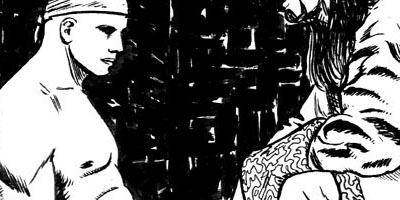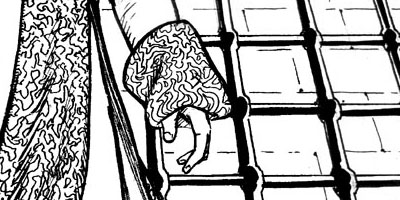But for now my weekly TV column is up at Torontoist.
21
Feb
21
Feb
18
Feb
Posit the first: the Guardians of the Universe are the super-evolved descendants of the Smurfs, who existed in the universe prior to the current DC Universe.
vs.
Posit the second: the Smurfs are evolutionary offshoots of the Guardians of the Universe, much like the Controllers or Zamarons, who eventually forgot their history.
DISCUSS.
17
Feb
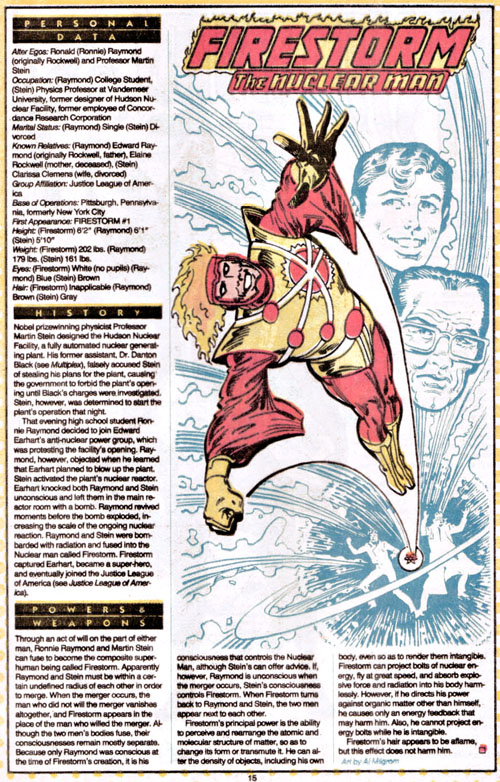
Firestorm suffers from a unique problem in comics, which is that he’s too powerful.
This is actually a rare thing to have happen. People complain that Superman is too powerful, but Superman gets an out because he’s Superman and his stories are often about the problems of being that powerful, particularly in relation to his friends and family, who aren’t.
But Firestorm is actually more powerful than Superman in a lot of ways. He doesn’t have the strength, but he’s pretty tough (and can turn intangible and doesn’t need to breathe and can absorb energy blasts); he’s got blasty powers and he can transmute matter at will (the “no organic matter” clause has been revoked, I think, three times now). This last one, as I have argued previously, makes him basically a godlike being. Which is fine, because superheroes can be that thing –
– but not all of them. And this is Firestorm’s problem: he is redundant, because he is designed to occupy the Superman slot in a universe where Superman already exists. Recall – as a way of demonstrating how this is the case – that in Superman Forever one of the Superman-analogues who comes along on the adventure is an alternate-universe Captain Atom who is basically a less immature Firestorm with a different costume.
It’s not an accident that all of Firestorm’s best character moments tend to come in stories where the really big guns have been taken out and he’s the only one left (JLA: Obsidian Age) or where the stakes are so big that Firestorm’s insane power level just makes him one of half-a-dozen godlike beings necessary to save the planet. (Crisis On Infinite Earths is the exemplar of this story type – and probably Firestorm’s best moment as a character, since in that story he basically becomes the Spider-Man of the godlike superhero set and gets most of the really good lines. I think this, along with some of the early 80s Justice Leagues where the JLA was fighting really high-stakes battles, are the best comics Firestorm has ever been in – and his character in them also informed the later early development of Kyle Rayner as a character. But I digress.)
The other way out of the “too powerful” trap is to up the scale and use the character in cosmic stories – see Green Lantern or Thor, for example. But Firestorm isn’t any good for this because he’s too grounded, because Firestorm’s weakness is that he’s too stupid to use his powers effectively, because understanding the elemental composition of matter is actually tricky. (At least, this is the case of the Ronnie Raymond incarnation, who seems to be the pre-eminent version of the character – even though I would argue the Jason Rusch version is superior.) It’s the sort of weakness that’s simultaneously a really clever idea and a really bad idea, since it’s original but also keeps Firestorm out of truly cosmic stories (because he’s a dummy) and instead fighting useless twats like these.
At this point I think the character is effectively mired in the dogshit he’s stuck in and needs a radical story revamp in order to be usable for the future, but that’s me. Shame. It’s an excellent costume.
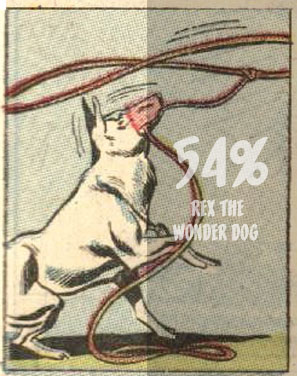
16
Feb
It looks like we’re not going to need to put in a captcha/registration system after all – not even one that uses cute kitties and doggies – as James has brilliantly managed to fix the WordPress theme problem that was causing the various spamblock plugins to fritz out, and they’re working excellently now.
This is the sort of you-wouldn’t-know-if-I-didn’t-tell-you thing that James does on a regular and totally volunteer basis to keep mgkdotcom running smoothly, which is why I reiterate my request from last week – if you can spare a little goodwill, hit up his wishlist, since among other things his rework on the site’s caching is what makes reading the comics that I’ve been putting up here with my various collaborators possible.
16
Feb
All we need is to do is hook up a generator to this perpetual motion machine!
(Although now I must know what the trick is.)
15
Feb
In the next couple of days I’m probably going to be installing a captcha system of some sort for commenting, simply because spam comment traffic has grown so intense that I’m literally killing 100-200 spam comments a day at this point.
I don’t like the idea of having to do it, because captcha is a pain and I doubt any of you like it any more than I do, but I really, really hate the spam comments. If I’m not going to turn a profit off my site then nobody will, dammit.
EDIT: Note that this is still a “probably,” since I am holding out hope that the new build of Akismet will take care of things. But it hasn’t yet.
15
Feb
Surely It Can’t Be Improved Archie
Posted by MGK Published in Archie (Improved Or Otherwise), Comics, Interactive Fun Time Party
14
Feb
If it ever goes berserk, one of the answers can be “love”
Posted by MGK Published in The Internets, TVMy weekly TV column is up at Torontoist.
14
Feb
The CRTC did something bad, but not quite as bad as the other bad things they’ve done recently, so a lot of people didn’t hear about it. I have attempted to correct that at Torontoist.
14
Feb
The Continuing Adventures of El Tyrano Magnifico
Posted by MGK Published in Comics, The Adventures of El Tyrano Magnifico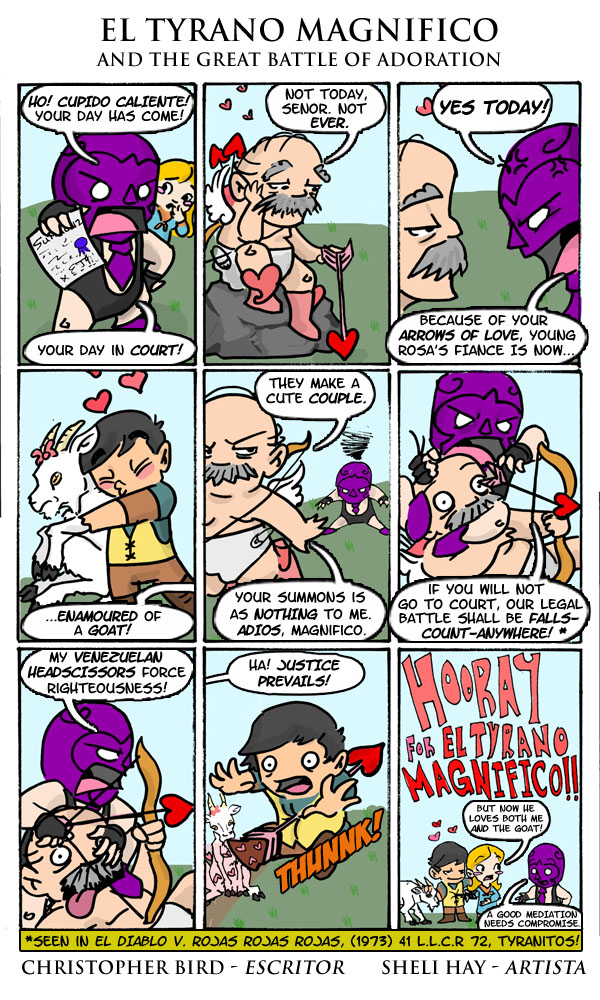
14
Feb
11
Feb
Heroes:
A-List: A hero who is capable of sustaining their own series for an extended period of time (possibly more than one series, but at least one.) If they guest star, they are given major billing on the cover and their presence is usually intended to be a sales boost to the title. May be known to the general public, although this is not a requirement. They are almost immune to comic book death; if they do die, their books do not cease publication and the character returns from death in no more than five years. Examples: Superman, Green Lantern, Spider-Man, Captain America.
B-List: A frequent recurring hero in their fictional universe, someone who is usually a regular in an ensemble book. They may or may not have gotten their own series, but usually have not been able to sustain one for more than about five years. They are generally popular, to the point where a casual observer might think them to be more popular than an A-list hero simply because of the clamor for them to get their own book. They make guest appearances on a fairly regular basis in other books, but are not always billed as such on the cover. They are relatively safe from comic book death, but they can die in major crossovers; however, they usually return within five years as well. Examples: Martian Manhunter, the Thing, the Beast, Guy Gardner.
C-List: These heroes usually enjoyed a brief spate of popularity at the beginning of their existence, only to fall out of favor with the comic reading public. They rarely appear in their fictional universe, and when they do, as often as not it’s simply to provide a “shocking” death in a major crossover. (C-list characters’ deaths are almost always permanent; if they do return, it’s most often with a different character bearing the same name/costume.) They are highly unlikely to get their own book or even to make regular appearances in other books; while they have their fans, they’re generally considered “cult” characters at best. Examples: Speedball/Penance, War Machine, Vigilante, Judomaster.
Villains:
A-List: These villains have lofty goals (world domination, destruction of the universe, unmitigated chaos) and the ability to achieve them. Their appearance is considered a significant event every time they show up, usually an occasion for serious difficulties for the hero and a major extended plotline is needed to defeat them. Heroes sometimes need help against A-list villains, and they can be the headliners of crossovers (but not always.) Their defeats will be less ignominious than other villains, and they may even have a few victories notched up on their belt. (Sometimes they wind up having their defeats explained away as the work of imposters, clones, or similar.) If they do die, it’s almost guaranteed that they will return from that state. Examples: Doctor Doom, Darkseid, Thanos, Lex Luthor.
B-List: These villains tend to have less interesting, more self-motivated goals (personal wealth and power, revenge against the hero or society, et cetera) and are of a lower level of power. They are still significant threats to the hero (although they become less so over time–it’s more likely for a B-list villain to become C-list than A-list) and they generally remain thematically tied to a single hero. They put up a good fight most of the time, and are still exciting to read about, but generally more because of their particular quirks and personality than because they present a major obstacle to the hero’s life. They are not immune to comic book death, but it’s generally presented as a major event when they die. Examples: Kraven the Hunter, the Abomination, Metallo, the Parasite.
C-List: These villains are usually hired out or serve as lackeys to more powerful villains; regardless of who they originally battled against, they now make appearances in any book where a “disposable” villain is called for. They do not present a significant threat to whatever hero they face, and indeed they usually wind up defeated in comically ignominious fashion; their power levels may or may not be low, but if they are powerful, they are not skilled enough to use their powers in a threatening fashion. They are frequently the targets of “edgy” heroes or other villains, who kill them to show how tough/uncompromising they are. If they are killed, as with C-list heroes, someone else usually winds up taking on their mantle. Examples: Plantman, the Constrictor, Terra-Man, Weather Wizard.
11
Feb
Peanut butter cookies are and will always be inferior to regular cookies with peanut butter smeared on them.
The best type of homemade fried rice is hot dog fried rice.
If you reduce 7Up enough, you eventually get something suitable for glazing ham that looks like Crystal Gravy from that SNL fake ad.
Beer can chicken is for wimps. Real cooks make Zima chicken.
If more people ate peameal roast, then the internet would probably shut up about bacon.
If you go to a state fair where they have a contest serving the weirdest fried food, sometimes a creepy little girl will hand you a plate of fried something and then seven days later you will die.
The next step in pizza is no-crust pizza. That’s right: pizza made entirely of cheese.
DISCUSS NERDS
10
Feb
Upcoming events in the previews for Spider-Man: Turn Off The Dark
Posted by MGK Published in Bad Comedy, ComicsMarch 13, 2011. Julie Taymor tells critics that the show is “nearly there,” but following the tragic death of Reeve Carney in a “freakish falling eighty feet incident” that previews will continue for another six months. Newspapers react with additional derision. Glenn Beck informs his audience that Taymor “made the right call.”
May 3, 2011. New Spider-Man actor Steve Zablawsky breaks both arms in the “jumping handstand” sequence invented by Taymor, who felt the second act “was missing something.” Glenn Beck tells his audience to invest in Spider-Man tickets.
August 8, 2011. Rumors fly that the show will become Spider-Girl when Taymor lets a female actor, Tracy Maclough, audition for the part of Spider-Man. Taymor denies these rumours, insisting that she is merely interested in what a woman might bring to the role of Spider-Man, and “exploring all her options.” She also points out that women are more flexible than men, which, following the tragic death of Steve Zablawsky, could be an asset to the show.
December 9, 2011. When asked about the ongoing fiasco of the show’s pre-production, Bono says “Spider-Man? I’ve never heard of Spider-Man. What does he do, then?” Bono gets violently angry when people suggest he is in any way involved with the show, that he knows who Spider-Man is, or that he was having an affair with the late Tracy Maclough. Glenn Beck devotes a week’s worth of episodes of his show to Bono’s connection to ACORN.
February 7, 2012. Taymor fires the entire cast and replaces them with midgets after Marvel decides to end their involvement with the show. Spider-Man is replaced with the character of Tiny-Man. The Green Goblin is now called the Short Goblin. The goddess Arachne remains the same, but is shorter. “We can get a lot more height on the aerial stunts because they’re lighter,” explains Taymor.
March 22, 2012. Julie Taymor-Beck tells critics that Tiny-Man: Step Up The Ladder is “in no way exploitative. We respect these actors, and the characters they play, for who they are” after critics suggest that the Cannon-O-Midgets sequence, where Tiny-Man fights the Short Goblin fifty feet above the stage to save the lives of dozens of fellow midgets, is completely and utterly tasteless. Glenn Beck explains how the Cannon-O-Midgets represents the failure of collectivism.
July 4, 2012. After a tragic exploding fireball kills forty actors and four members of the audience during the Cannon-O-Midgets sequence, production is halted on Tiny-Man: Step Up The Ladder. Glenn Beck suggests that liberal elites killed the show out of jealousy.
October 7, 2012. DC Comics announces it is buying all rights to Tiny-Man: Step Up The Ladder and will hire Taymor to repurpose it as a Batman musical entitled Batman: Turn In The Dark. Taymor later explains her vision to reinvent Batman as a gargoyle who listens to punk rock and who is desperately in love with Gwen Stacy. Glenn Beck says “this will make Batman accessible to millions of people.”
Search
"[O]ne of the funniest bloggers on the planet... I only wish he updated more."
-- Popcrunch.com
"By MightyGodKing, we mean sexiest blog in western civilization."
-- Jenn
Contact
MGKontributors
The Big Board
MGKlassics

Blogroll
- ‘Aqoul
- 4th Letter
- Andrew Wheeler
- Balloon Juice
- Basic Instructions
- Blog@Newsarama
- Cat and Girl
- Chris Butcher
- Colby File
- Comics Should Be Good!
- Creekside
- Dave’s Long Box
- Dead Things On Sticks
- Digby
- Enjoy Every Sandwich
- Ezra Klein
- Fafblog
- Galloping Beaver
- Garth Turner
- House To Astonish
- Howling Curmudgeons
- James Berardinelli
- John Seavey
- Journalista
- Kash Mansori
- Ken Levine
- Kevin Church
- Kevin Drum
- Kung Fu Monkey
- Lawyers, Guns and Money
- Leonard Pierce
- Letterboxd – Christopher Bird - Letterboxd – Christopher Bird
- Little Dee
- Mark Kleiman
- Marmaduke Explained
- My Blahg
- Nobody Scores!
- Norman Wilner
- Nunc Scio
- Obsidian Wings
- Occasional Superheroine
- Pajiba!
- Paul Wells
- Penny Arcade
- Perry Bible Fellowship
- Plastikgyrl
- POGGE
- Progressive Ruin
- sayitwithpie
- scans_daily
- Scary-Go-Round
- Scott Tribe
- Tangible.ca
- The Big Picture
- The Bloggess
- The Comics Reporter
- The Cunning Realist
- The ISB
- The Non-Adventures of Wonderella
- The Savage Critics
- The Superest
- The X-Axis
- Torontoist.com
- Very Good Taste
- We The Robots
- XKCD
- Yirmumah!
Donate
Archives
- August 2023
- May 2022
- January 2022
- May 2021
- January 2021
- December 2020
- October 2020
- June 2020
- March 2020
- January 2020
- December 2019
- October 2019
- February 2019
- January 2019
- December 2018
- April 2018
- March 2018
- February 2018
- January 2018
- December 2017
- November 2017
- October 2017
- February 2017
- January 2017
- December 2016
- November 2016
- October 2016
- September 2016
- August 2016
- July 2016
- June 2016
- May 2016
- April 2016
- March 2016
- February 2016
- January 2016
- December 2015
- November 2015
- October 2015
- September 2015
- August 2015
- July 2015
- June 2015
- May 2015
- April 2015
- March 2015
- February 2015
- January 2015
- December 2014
- November 2014
- October 2014
- September 2014
- August 2014
- July 2014
- June 2014
- May 2014
- April 2014
- March 2014
- February 2014
- January 2014
- December 2013
- November 2013
- October 2013
- September 2013
- August 2013
- July 2013
- June 2013
- May 2013
- April 2013
- March 2013
- February 2013
- January 2013
- December 2012
- November 2012
- October 2012
- September 2012
- August 2012
- July 2012
- June 2012
- May 2012
- April 2012
- March 2012
- February 2012
- January 2012
- December 2011
- November 2011
- October 2011
- September 2011
- August 2011
- July 2011
- June 2011
- May 2011
- April 2011
- March 2011
- February 2011
- January 2011
- December 2010
- November 2010
- October 2010
- September 2010
- August 2010
- July 2010
- June 2010
- May 2010
- April 2010
- March 2010
- February 2010
- January 2010
- December 2009
- November 2009
- October 2009
- September 2009
- August 2009
- July 2009
- June 2009
- May 2009
- April 2009
- March 2009
- February 2009
- January 2009
- December 2008
- November 2008
- October 2008
- September 2008
- August 2008
- July 2008
- June 2008
- May 2008
- April 2008
- March 2008
- February 2008
- January 2008
- December 2007
- November 2007
- October 2007
- September 2007
- August 2007
- July 2007
- February 2007
Tweet Machine
- No Tweets Available
Recent Posts
- Server maintenance for https
- CALL FOR VOTES: the 2021 rec.sport.pro-wrestling Awards
- CALL FOR NOMINATIONS: The 2021 rec.sport.pro-wrestling Awards (the Theszies)
- The 2020 RSPW Awards – RESULTS
- CALL FOR VOTES: the 2020 Theszies (rec.sport.pro-wrestling Awards)
- CALL FOR NOMINATIONS: The 2020 Theszies (rec.sport.pro-wrestling awards)
- given today’s news
- If you can Schumacher it there you can Schumacher it anywhere
- The 2019 RSPW Awards – RESULTS
- CALL FOR VOTES – The 2019 RSPW Awards (The Theszies)
Recent Comments
- George Leonard in When Pogo Met Simple J. Malarkey
- Blob in How Jason Todd Went Wrong A Second Time
- Cindi Chesser in Thursday WHO'S WHO: The War Wheel
- Scott Hater in Bing, Bang, Bing, Fuck Off
- dan loz in Hey, remember how we talked a while a back about b…
- Sean in Server maintenance for https
- Ethan in CALL FOR VOTES: the 2021 rec.sport.pro-wrestling A…
- wyrmsine in ALIGNMENT CHART! Search Engines
- Jeff in CALL FOR VOTES: the 2021 rec.sport.pro-wrestling A…
- Greg in CALL FOR VOTES: the 2021 rec.sport.pro-wrestling A…
